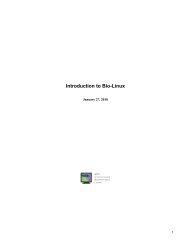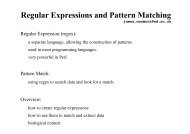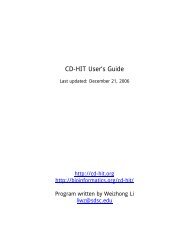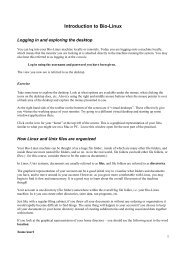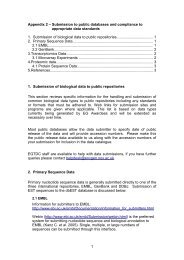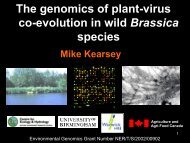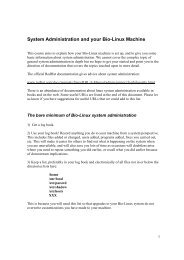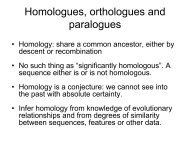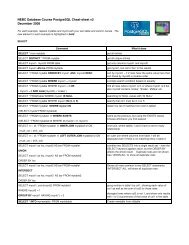Introductory Bioinformatics For Users: The Course Notes
Introductory Bioinformatics For Users: The Course Notes
Introductory Bioinformatics For Users: The Course Notes
You also want an ePaper? Increase the reach of your titles
YUMPU automatically turns print PDFs into web optimized ePapers that Google loves.
4.5 Blast . . . . . . . . . . . . . . . . . . . . . . . . . . . . . . . . . . 294.5.1 How Blast works . . . . . . . . . . . . . . . . . . . . . . . 294.5.2 Blast releases . . . . . . . . . . . . . . . . . . . . . . . . . 294.5.3 Blast flavours . . . . . . . . . . . . . . . . . . . . . . . . . 294.5.4 Filtering in blast . . . . . . . . . . . . . . . . . . . . . . . 294.5.5 Results formatting for web-based NCBI blast . . . . . . . 304.5.6 Scoring in NCBI blast . . . . . . . . . . . . . . . . . . . . 394.5.7 Recent Blast scoring developments . . . . . . . . . . . . . 424.6 Searching with profiles . . . . . . . . . . . . . . . . . . . . . . . . 435 Basic tasks in bioinformatics 445.1 Examples of basic tasks . . . . . . . . . . . . . . . . . . . . . . . 445.1.1 Sequence formatting . . . . . . . . . . . . . . . . . . . . . 445.1.2 Finding ORFs and/or genes . . . . . . . . . . . . . . . . . 445.1.3 Vector marking and clipping . . . . . . . . . . . . . . . . 465.1.4 PCR primer design . . . . . . . . . . . . . . . . . . . . . . 465.1.5 Graphical viewing of data and annotation . . . . . . . . . 466 General tips 476.1 Computing related . . . . . . . . . . . . . . . . . . . . . . . . . . 476.2 Sequence formatting . . . . . . . . . . . . . . . . . . . . . . . . . 476.3 Filenames . . . . . . . . . . . . . . . . . . . . . . . . . . . . . . . 486.4 Data standards and data submission . . . . . . . . . . . . . . . . 496.4.1 Standards and ontologies . . . . . . . . . . . . . . . . . . 496.4.2 Data submission . . . . . . . . . . . . . . . . . . . . . . . 506.5 Local versus remote, web-based software . . . . . . . . . . . . . . 506.6 Finding programs and documentation . . . . . . . . . . . . . . . 516.7 Keeping track, keeping results and keeping up . . . . . . . . . . . 516.7.1 Keeping track . . . . . . . . . . . . . . . . . . . . . . . . . 516.7.2 Keeping results . . . . . . . . . . . . . . . . . . . . . . . . 516.7.3 Keeping up . . . . . . . . . . . . . . . . . . . . . . . . . . 522
Chapter 2Sequence andsequence-related databases<strong>The</strong>re are many freely available data resources. A large number are hostedby large national and international institutions such as the American center,the National Center for Biotechnology Information (NCBI) and the European<strong>Bioinformatics</strong> Centre (EBI).<strong>The</strong>re are also many specialist centres and research groups offering data resources.Some of these are available for searching via their own web pages andin some cases.Many sequence databases can also be downloaded in parts or in their entiretyto use locally, or can be accessed at the remote location using web pages, webservices and sometimes, specialised software on your own machine.A word of warning. Many sequences in the database have been annotated bytransferring annotation from the most similar sequence in the database alreadyannotated. That sequence in turn may have been annotated the same way.Many sequences known to be quite similar may, in fact, have different functionwhen investigated experimentally rather than purely in silico. <strong>The</strong> lesson isto use evidence codes 1 when they are available to help you judge how muchconfidence to put in a particular annotation.2.1 Nucleotide repositories2.1.1 EMBL, GenBank and DDBJ<strong>The</strong>re are three main nucleotide repositories: EMBL (European), GenBank(American), and DDBF (Japanese). <strong>The</strong>se repositories hold annotated nucleotidesequences.1 <strong>For</strong> example, look at the PE (protein existence) line in Swissprot. <strong>The</strong>re are 5 evidencecodes: 1: evidence at protein level, 2: evidence at transcript level, 3: inferred from homology,4: predicted, 5: uncertain5
XXKW EST.XXOS Plasmodium falciparum (malaria parasite P. falciparum)OC Eukaryota; Alveolata; Apicomplexa; Aconoidasida; Haemosporida; Plasmodium;OC Plasmodium (Laverania).XXRN [1]RP 1-164RX PUBMED; 17895392.RA Normark J., Nilsson D., Ribacke U., Winter G., Moll K., Wheelock C.E.,RA Bayarugaba J., Kironde F., Egwang T.G., Chen Q., Andersson B., Wahlgren M.;RT "PfEMP1-DBL1{alpha} amino acid motifs in severe disease states ofRT Plasmodium falciparum malaria";RL Proc. Natl. Acad. Sci. U.S.A. 104(40):15835-15840(2007).XXCC Contact: Nilsson DCC Department of Cell and Molecular BiologyCC Karolinska institutetCC Berzeliusv 35, SE-17177, Stockholm, SwedenCC Tel: 46 8 52483991CC Email: daniel.nilsson@ki.seCC PCR PRimersCC FORWARD: nDBLfCC BACKWARD: alpha-BRCC Seq primer: M13 forward primerCC High quality sequence stop: 164.XXFH Key Location/QualifiersFHFT source 1..164FT/organism="Plasmodium falciparum"FT/lab_host="Homo sapiens"FT/isolate="UKS10"FT/mol_type="mRNA"FT/dev_stage="Trophozoite"FT/clone_lib="Ugandan isolate UKS10 Pf var gene cDNA"FT/clone="UKS10nFBr13"FT/tissue_type="Blood"FT/note="Vector: pcrII-TOPO; Blood samples were drawn fromFTUgandan children with mild or severe malaria. Isolate UKS10FTfrom Kampala, Uganda originated from a patient sufferringFTfrom severe malaria. Erythrocytes were separated from otherFTblood constituents and cultured until parasites maturedFTinto trophozoites. Trophozoites were enriched, and totalFTRNA extracted. Reverse transcription with random hexamerFToligonucleotides and DNAse treatment gave single strandedFTcDNA. Three different pairs of primers (alpha-AF/alpha-BR,FTnDBLf/nDBLr, nDBLf/alpha-BR) were used to PCR amplify theFT var gene/PfEMP1 DBL1alpha domain from cDNA. A set of 487
FTFTFTXXSQ//clones were obtained from each reaction and sequenced oncefrom each direction."/db_xref="taxon:5833"Sequence 164 BP; 63 A; 25 C; 32 G; 44 T; 0 other;tggcagccaa atatgagggg gacttaataa aaacacgtta tacaccatat caacaaatat 60atggtgattc tgcttcccaa ttatgtactg tattagcacg aagtttcgca gatataggcg 120atattataag aggaaaagat ctgtatctcg gtgaataaaa aaaa 1642.1.4 RefSeqRefSeq (Reference Sequence) is a curated collection of DNA, RNA, and proteinsequences built by the NCBI. RefSeq provides one example of each natural biologicalmolecule for organisms with enough available information. (In January,2007, this amounted to data for approximately 4000 different organisms.) <strong>For</strong>each model organism, RefSeq aims to provide separate and linked records forthe genomic DNA, the gene transcripts, and the proteins arising from thosetranscripts.To produce RefSeq records, NCBI culls the best available information oneach molecule and updates the records as more information emerges. You couldthink of GenBank as the primary literature of sequences, while RefSeq is morelike the review literature of sequences.RefSeq entries can be easily distinguished from GenBank entries; they havean accession prefix with an underscore, and a notation in the comment fieldthat indicates the RefSeq status 3 .Characteristics of entries in RefSeq• NCBI staff hand-curate entries using data sources including GenBank.• Records are revised by NCBI staff as additional information becomes available.• Single entries for each sequence for an organism.• Predicted or known proteins coded for by the sequence are linked to viatheir accession number in the Uniprot knowledgebase. Transcripts are alsolinked.• Only information from major model organisms are included in RefSeq.<strong>The</strong> software we will be using today is hosted by the European <strong>Bioinformatics</strong>Institute (EBI), which maintains the EMBL database, and the National Centerfor Biotechnology Information (NCBI), which is based in the USA and hostsGenBank.3 An example of a RefSeq accession id is XP 001271868, while an example GenBank orEMBL accession is DS027054.8
2.2 Peptide repositories2.2.1 Uniprot-knowledgebase<strong>The</strong> main peptide database in use is called Uniprot-knowledgebase. It isa results of a merger of the efforts of three databases that had earlier been heldand curated separately: <strong>The</strong> Swiss Institute of <strong>Bioinformatics</strong> and the EBI’sSwissProt and TrEMBL databases, and Georgetown Universitys PIR-PSDdatabase.<strong>The</strong> history of Uniprot is still apparent in the divisions within it: SwissProtand TrEMBL.Uniprot-SwissProt is the ”gold” standard of public databases; it consistsof manually-annotated records. SwissProt records are cross-referenced to morethan 50 different databases.Uniprot-TrEMBL consists of predicted coding sequences (CDS regions) asannotated in the primary nucleotide databases. (<strong>The</strong>re is some additional mergingand adjustment before inclusion in TrEMBL.) TrEMBL and SwissProt arenon-redundant. Peptides from TrEMBL that are shown to exist and are thenannotated are promoted into SwissProt.Swissprot contains high quality information and is much smaller than TrEMBL;in general SwissProt is a good place to start your searches, whether in searchingthe metadata or the sequence data itself.All protein sequences encoded by the same gene are merged into a singleUniProt-SwissProt entry. Differences among sequencing reports are analysedand fully described in the feature table (e.g. alternative splicing events, polymorphismsor conflicts).This course concentrates on accessing sequences via portals with access tomany databases such as SRS and Entrez. However, the home sites for manydatabases can offer intuitive and comphrensive interfaces for data exploration.<strong>For</strong> example, you might like to visit the new Uniprot website to investigateparticular proteins. <strong>The</strong> interface makes it particularly easy to see the evidencefor the annotation included in an entry. <strong>The</strong> cross reference section is also veryintuitive.9
2.2.2 Anatomy of a Uniprot entryID LDH_PLAFA Reviewed; 42 AA.AC P13774;DT 01-JAN-1990, integrated into UniProtKB/Swiss-Prot.DT 01-JAN-1990, sequence version 1.DT 24-JUL-2007, entry version 35.DE L-lactate dehydrogenase (EC 1.1.1.27) (LDH-P) (Fragment).OS Plasmodium falciparum.OC Eukaryota; Alveolata; Apicomplexa; Aconoidasida; Haemosporida;OC Plasmodium; Plasmodium (Laverania).OX NCBI_TaxID=5833;RN [1]RP NUCLEOTIDE SEQUENCE [GENOMIC DNA].RX MEDLINE=85240418; PubMed=3892292; DOI=10.1016/0166-6851(85)90122-7;RA Simmons D.L., Hyde J.E., Mackay M., Goman M., Scaife J.;RT "Cloning studies on the gene coding for L-(+)-lactate dehydrogenase ofRT Plasmodium falciparum.";RL Mol. Biochem. Parasitol. 15:231-243(1985).CC -!- CATALYTIC ACTIVITY: (S)-lactate + NAD(+) = pyruvate + NADH.CC -!- PATHWAY: Anaerobic glycolysis; final step.CC -!- SUBUNIT: Homotetramer.CC -!- SIMILARITY: Belongs to the LDH/MDH superfamily. LDH family.CC -----------------------------------------------------------------------CC Copyrighted by the UniProt Consortium, see http://www.uniprot.org/termsCC Distributed under the Creative Commons Attribution-NoDerivs LicenseCC -----------------------------------------------------------------------DR EMBL; M14818; AAA29634.1; -; Genomic_DNA.DR GO; GO:0004459; F:L-lactate dehydrogenase activity; IEA:EC.DR InterPro; IPR011304; L_LDH_NAD.DR PROSITE; PS00064; L_LDH; PARTIAL.PE 3: Inferred from homology;KW Glycolysis; NAD; Oxidoreductase.FT CHAIN 42 L-lactate dehydrogenase.FT/FTId=PRO_0000168496.FT NON_TER 1 1FT NON_TER 42 42SQ SEQUENCE 42 AA; 4955 MW; 7FE28FDC341F474B CRC64;LLVYDNLLLN DKNEMNKDSS YDKKTNALDN YKNDSTIDME KK//10
Note that all of the above models assume that time is reversible and thatall the different sites in the sequence evolve at the same rate. <strong>The</strong> gammadistribution can be used to model the distribution of the rates found at differentsites.Choices of nucleotide substitution model is particularly important in phylogeneticanalyses. However, this is beyond the scope of this course.3.2.2 Amino acid modelsIn general terms, we need a 20 x 20 matrix containing scores to assign toeach possible amino acid pairing in an alignment. <strong>The</strong>re are two main modelfor amino acid evolution, the PAM model and the BLOSUM model. <strong>The</strong>reare many variations on their themes.Both PAM and BLOSUM scoring system are based on log-odds (lod) scores.Examples of two of the BLOSUM series of socring matrices are shown in figure3.1 on page 15. Note that the scores provided in the matrices are scaled andthen rounded to the nearest integer value 5 . This scaling does not affect whatalignments are chosen, but make working with the scoring system much easier.We will cover some of the details about amino acid scoring matrices duringthe class.Specialist scoring matrices BLOSUM and PAM matrices are general purposematrices. If the general characteristics of proteins of interest are quitedifferent than the ”average”, then there are various options available to consider.<strong>For</strong> example, scoring matrices for the protein type of interest could bederived. Examples of this are the SLIM and PHAT matrices for transmembraneproteins [Ng et al., 2000, Muller et al., 2001].3.2.3 GapsGaps are difficult to handle. We have to decide how to score them, and ourchoices greatly affect the results of alignment or sequence search programs, anddo not necessarily reflect evolutionary biology. Some effects of gap choices willbe illustrated in the section about the Clustalw alignment software.In practical terms, gap opening and gap extension scores are not usually thesame. If gaps are scored the same no matter where they are in a sequence, thenwe could get a situation where an alignment of two coding sequences that differdue to the insertion of a single gap of 9 nucleotides (or 3 amino acids) is scoredthe same as an alignment with 9 gaps inserted willy-nilly along the sequences.Which is more likely to have occurred from an evolutionary perspective? If wepenalise heavily for opening a gap, but penalise relatively lightly for extendinga gap that is already open, we would score the former alignment more favorablythan the latter.5 I.e. the matrices do not contain the raw log-odds scores. This fact is useful for understandingsome of the details involved in scoring sequence database search results.14
Figure 3.1: A couple of examples of global and local alignment differences.15
3.3 Dynamic programming and heuristicsAlgorithm, Dynamic programming and heuristics are terms you should befamiliar with when considering sequence alignment software.Algorithms are a set or ordered steps, essentially a recipe, for solving a problem.Different algorithms may be available to solve the same problem. If youwere programming a computer to carry out the steps to solve your problem, youwould want to consider who much memory and how much time the particularset of steps (i.e. the algorithm) you chose would take. <strong>For</strong> example, as yourproblem gets bigger, does the amount of computer time and/or memory growlinearly, polynomially, factorially, exponentially?Dynamic programming is a way of solving problems where you make thebest decision at each step along the way to your solution. With regards toalignment, this (in essence) allows you to figure out your best alignment bytracing a route through the options at each position in the alignment (i.e. match,mismatch, gap) that give you the highest score. <strong>The</strong>re are many books thatexplain dynamic programming as it pertains to sequence alignment. <strong>For</strong> today,just remember that it is a way of solving problems that is good, but reasonablycomputationally intensive.A heuristic is essentially a short cut that makes a problem tractable and thatwill give us a good solution most of the time. We cannot, however, prove thatthe solution we get is the best one. <strong>For</strong> example, in terms of sequence alignment,trying to search a large sequence database using a dynamic programmingalgorithm would take a lot of memory and a huge amount of time. Even amultiple sequence alignment for more than three or four sequences could taketoo long to carry out. So people design heuristics - reasonable shortcuts that(hopefully) provide reasonable answers. Of course, we need to remember thatwe took some short cuts when we interpret our results, especially when tryingto figure out what happened if our results look strange.Some heuristic algorithms, including the ones we will touch on when discussingmultiple sequence alignments, are greedy. This means short-term decisionsare made in solving the problem; hence the final solution will be heavilyinfluenced by short-sighted decisions made early on 6 .Remember that in all cases, the optimal alignment between sequences willdepend on the socring matrix and gap penalty system you use.3.4 Pairwise alignment strategies3.4.1 Global and local alignmentsIn brief, global alignment algorithms will align two sequences over both oftheir entire lengths. Local alignment algorithms will look for the best subalignmentsbetween two sequences. This may include the whole of each sequence,6 We will see this effect demonstrated using the Clustalw alignment program.16
the whole of one of the sequences, or just parts of each sequence. Figure 3.2on page 18 shows a couple of examples where a global alignment and a localalignment algorithm have been applied to pairs of sequences.<strong>The</strong> two key algorithms for pairwise alignment are Needleman-Wunsch (global)and Smith-Waterman (local). Many programs implement some form of eitherof these 7 .Both global and local algorithms seek to find the highest scoring alignments.Some programs report only the highest scoring alignment, others will reportmultiple highest scoring alignments. If time permits, how scores are calculatedfor both algorithm types will be discussed in the class.Needleman-Wunsch and Smith-Waterman algorithms employ dynamic programming.That is, they are guaranteed to find the highest scoring alignment.Of course, the highest scoring alignment is not necessarily the correct one!Unless sequences are known to be homologous for their entire length, localalignment algorithms should be used.3.4.2 Software for pairwise alignment<strong>The</strong>re are many programs that will do basic pairwise alignment. A few are listedbelow.Global alignment (Needleman-Wunsch)• needle• stretcher• lagan• chaosLocal alignment (Smith-Waterman)• water• matcher• ssearch• spideyMixed global and local• shuffle-lagan7 In your reading, if you see Smith-Waterman, think local pairwise alignment. Similarly,when you see Needleman-Wunsch, read global pairwise alignment17
Figure 3.2: A couple of examples of global and local alignment differences.18
3.5 Multiple sequence alignmentMultiple sequence alignment is a key part of sequence-based bioinformatics.<strong>For</strong> example, a good alignment could illuminate conserved elements important tofunction, inform structural predictions, or allow phylogenetic tree estimation.As a corollary, if your alignment is bad, your downstream analyses will bemeaningless...or worse, deceptive!Even for a small number of sequences (e.g. 4 or more), a full dynamic programmingsolution to finding the optimal alignment would take far too long formost sequences. So, heuristic solutions have been devised. <strong>The</strong> most commonlyused is progressive alignment.We will consider progressive alignment algorithm as implemented by clustalw,as this is one of the most common multiple alignment programs. We will thencomment briefly on some readily available software that may generate betteralignments.3.5.1 Clustalw - a case study of progressive alignmentClustalw is a global alignment method. <strong>The</strong> general algorithm it employs is:• Do a quick, global pairwise alignment of each pair of sequences in the set.• Create a quick, approximate phylogenetic tree 8 .• Build the multiple sequence aligment by progressively aligning pairs ofsequences according to their relationship in the approximate tree.<strong>The</strong> above description misses out all the detail, but the general point is thatthe algorithm breaks down the multiple sequence alignment problem to a seriesof pairwise alignment problems. Note that because sequences are aligned in pairsin the order specified by the approximate tree, any alignment decisions made (e.g.the introduction of gaps) for closely related sequences, will be carried throughto later stages of the alignment 9 . This is illustrated in figure 3.3 on page 20.8 Important: Do not use this as a phylogenetic tree!9 This is an example of a greedy algorithm.19
Figure 3.3: Guide tree ordering effect on clustalw alignments. a) <strong>The</strong> guide tree produced for the sequences. b) <strong>The</strong> first section of theresulting alignment using Clustalw default settings. <strong>The</strong> red circles mark one place where the progressive alignment may perhaps haveplaced residues in a less than optimal position.20
As mentioned earlier, the scoring matrix 10 and gap penalties chosen greatlyaffect the resulting alignments. This is illustrated in figure 3.4 on page 22.10 By default, Clustalw uses the Gonnet series of matrices. <strong>The</strong>se were derived similarly tothe PAM matrices, but based on more and more recent data. Note that <strong>The</strong> actual matrixused by Clustalw depends on how similar the sequences to be aligned at a given alignmentstep are.21
Figure 3.4: Choice of gap pentalties can greatly affect the resulting alignment. Clustalw defaults for the pairwise and multiple alignmentgap extension penalities, 0.1 and 0.2 respectively, were used for all alignments. a) Clustalw default gap opening penalty of 10 for pairwiseand multiple alignments, b) gap opening penalty of 2 for pairwise and multiple alignments. All alignments used the Gonnet series ofscoring matrix.22
Key issues to look at when deciding whether an automatically generatedmultiple alignment is reasonable include whether functional motifs line up andwhether gaps have been introduced in regions likely or unlikely to contain them.If you have access to secondary structure information, this can also be used tomanually improve the alignment.<strong>The</strong> global nature of clustalw means that you should only use this programon sequences of similar length. You may need to edit your sequences so the areof similar length before proceeding, or you may need to consider programs usingother algorithms more suitable for what you are trying to do.3.5.2 Other multiple sequence alignment software<strong>The</strong>re are many other multiple sequence alignment algorithms implemented.<strong>The</strong> most common programs use variations of progressive alignment, but theydiffer in attributes like whether and on what basis an initial guide tree is produced,how many rounds of progressive alignment are undertaken, whether thereare alignment refinement stages, what scoring systems are used, and so on. <strong>The</strong>choices made for any given piece of software affects how well it aligns sequences,and particularly, how well it may align sequences with particular characteristics.<strong>The</strong> choices also affect how long the program takes to run.Some software to look into when you come to generating your own sequencesinclude:• Muscle for general peptide multiple sequence alignment [Edgar, 2004] .• T-coffee and M-coffee for general peptide multiple sequence alignment[Notredameet al., 2000, Wallace et al., 2006].• Lagan and MLagan for aligning long homologous sequences [Brudno et al.,2003].3.5.3 Profile alignmentWe will discuss sequence profiles and their alignment briefly during the course.In terms of accuracy, profile-profile alignments tend to be more accurate thanprofile-sequence alignments, which are in turn, more accurate than sequencesequencealignments.A key software package to consider when working with profiles is Hmmer[Eddy, 1998].3.5.4 Alignment EditorsAs will hopefully be obvious by now, you will often have to work on an aligmentmanually before using the alignment as the basis for downstream analyses. Someprograms including sequence alignment editors are listed below.• Mega [Tamura et al., 2007]23
• Jalview [Clamp et al., 2004]• Cinema [Lord et al., 2002]• Seaview [Galtier et al., 1996]24
Chapter 4Searching sequence-baseddatabases4.1 IntroductionWe looked at searching sequence annotation earlier. Here we will look at a varietyof search programs that are used to search for similar sequences in sequencedatabases. If time permits, profile searching software and profile databases willbe discussed during the class.<strong>The</strong> programs we look at today are available via the web. However, manyof them can be installed on your local machine to search databases held onyour local machine or held remotely. We will discuss the pros and cons of usingremote and local services and databases during the course.<strong>The</strong>re are many types of sequence-based searches you could consider doing.<strong>For</strong> example:• Search a sequence databases for similar sequences• Search a profile or pattern database with a sequence• Search a sequence database with a pattern or profileUnderlying all database searching programs is the idea of pattern matching.<strong>The</strong> differences between programs comes down to the types of patterns you aresearching with, the types of patterns you are searching against, and the way theprograms go about finding matches between them. Most database searchingsoftware will include some statistical measure of the significance of matchesfound.4.2 Health warningsDatabase searching should be approached like an experiment. Youshould define your aims before your start. This will save you an enormous25
amount of time, both in terms of working on the computer with your sequence,and also when trying to bring together and report your findings later.Before you start searching with a sequence, it is useful to outline answers toquestions like the following:• What am I trying to find out/What do I want to do with the results?• What kind of database do I want to search with my sequence? E.g. nucleotide,protein, pattern, profile?• Which database(s) in particular do I want to search? Why?• Are there are any subsets of the database that I might want to restrict mysearch to?• Do I want to take into account potential frameshifts in my coding sequences?• What format is my sequence in 1 ?• Do I want to filter my sequence for repeats and low complexity regionsbefore searching?• Is the scoring system I’ve chosen appropriate?4.3 Some terminology and considerations4.3.1 TermsSensitivity <strong>The</strong> ability to detect true matches. <strong>The</strong> most sensitive searchmay retrieve many true positives, but could also return many false positives.Specificity <strong>The</strong> ability to find only true matches. <strong>The</strong> price for a very specificsearch could be that some true matches will be missed.Query sequence<strong>The</strong> sequence you are searching with.Subject sequence <strong>The</strong> sequence you are comparing your query sequence to.You could think of a sequence database as made up of many subject sequences.Word In the context of sequence comparisons, a number of consecutive residues.E.g. a word size of 11 for nucleotides means a group of 11 consecutive nucleotidesin the sequence.Ktup A synonym for word in the context of sequence comparison. Used particularlywith the programs in the Fasta package.1 <strong>The</strong> issue of sequence formats is no longer the problem it once was. Many programsare capable of dealing with different sequence formats. <strong>For</strong> programs that cannot, there are anumber of format translators. A good one is seqret available as part of the EMBOSS package.26
E-value A statistical score, based on the extreme value distribution, used tointerpret the results of database searches. In general terms, E-values indicatethe number of alignments expected by chance when carrying out a search justlike the one you just did. This is discussed in further detail later in this chapter.<strong>For</strong> small E values (e.g. < 0.001), this is the same as the probability of findingan alignment as good as the one you found in a search like the one you just didby random chance.HSP A High scoring Segment Pairs are segments of your sequence that matcha sequence in the database. Such segments are given a score, and if that scoreexceeds a set value, the program attempts to find longer matching areas in thispair of sequences.MSP A Maximal-scoring Segment Pair is the segment pair with the highestscore in a pairwise comparison.Raw score <strong>The</strong> score of an alignment, calculated as the sum of substitutionand gap scores. Because of differences between scoring matrices, raw scores arenot always directly comparable.Bit score Bit scores are derived from the raw alignment score, but are normalizedwith respect to the scoring system. Bit scores can be used to comparealignment scores from different searches. 2Scoring matrix A matrix containing the scores that are given to pairs ofamino acids or nucleotides when aligning them.4.3.2 Searching sequences with sequences - generalities<strong>The</strong>re is software available that will allow you to do a Smith-Waterman localpairwise alignment of your sequence of interest with every other sequence ina database. However, this can be very slow. A variety of software has beenwritten to make searching sequence databases with other sequences much faster.This speed is attained through the use of ”heuristic” algorithms. <strong>The</strong> choice ofalgorithm affects the speed of the program, and also the quality of the results.In many cases you can set the values of parameters used during the search,which will also affect the results returned.<strong>The</strong> most commonly used heuristic algorithms for searching sequence databasesare Fasta[Pearson, 1990], and Blast (including the closely related psi-blast)[Altschulet al., 1997].4.3.3 Filtering and MaskingNucleotide and amino acid sequences often contain low-complexity regions.<strong>The</strong>se are relatively uninformative regions such as short tracts of repeats likeproline-rich regions or poly-A tails, Alu sequences in humans, etc. Searching2 Specifically, they are raw scores that have been converted from the log base of the scoringmatrix that creates the alignment to log base 2.27
using sequences containing such regions is likely to return many non-related,yet high scoring sequences.Filtering/masking can improve searches.Programs have been devised to filter unwanted segments of sequence fromwithin a larger sequence. Generally, these programs identify low complexityregions in the query sequence and replace them with a series of N’s (in the caseof nucleotide sequences), or X’s (in the case of peptide sequences). One N orone X replaces each residue in the region.Masking. In contrast to filtering, word masks do not alter the sequence itself.Rather, they cause certain portions of the query sequence to be skipped duringthe neighborhood word generation step of the BLAST algorithm 3 . Here, thequery sequence is kept intact when generating comprehensive alignments, butthese alignments are seeded by neighborhood word hits involving only the moreinformative, unmasked regions of the sequence.If you filter a query sequence, your score will be reduced 4 It is recommendedthat you start out using soft masking, where the filtering is applied during theword seeingn stage, but not used during the extension phase 5 .4.4 Fasta<strong>The</strong> Fasta package contains a number of database searching programs. On thesurface, these are similar to the more widely-used blast family of programs, butthere are key differences in the implementations of the two packages. Currentversions of Blast should yield similar sensitivity and specificity to searches usingFASTA, and will run much faster. However, you may find hits using FASTAthat are not found in a Blast search and vice versa.In addition, there are programs available within the Fasta package that havefunctionality that is not replicated exactly among the Blast family of programs.Examples of this are the fastx and fasty programs, making allowances for gapsand frameshifts when comparing nucleotides to peptide databases.Due to time constraints, we will not be able to consider the Fasta packagefurther during this course.3 <strong>The</strong> way Blast works will be described during the class.4 <strong>For</strong> example, in default versions of blast for amino acid searches, amino acids paired witha masked position are given a fixed negative score. Filtered query sequences can also resultin the loss of some alignments because HSPs may be broken into smaller HSPs, which mightdrop the score too low for that match to be kept.5 <strong>The</strong>se phases are explained in section 4.528
4.5 Blast4.5.1 How Blast worksA general outline of how blast works will be covered during the class.4.5.2 Blast releases<strong>The</strong>re are two main releases of blast: NCBI Blast and Wu-Blast. <strong>For</strong> many, theNCBI blast release is more familiar. Wu-blast is faster [Korf et al., 2003] andoffers other advantages 6 . <strong>The</strong> majority of publicly available blast servers offerNCBI rather than Wu-blast, but both are available at the EBI.4.5.3 Blast flavoursDifferent flavours of blast are used for different types of searches. See table4.1.Table 4.1: Blast flavoursFlavour Query type Subject type(db type)blastn nucleotide nucleotideblastp peptide peptideblastx nucleotide peptidetblastn peptide nucleotidetblastx nucleotide nucleotideBlastx, tblastn and tblastx all take a nucleotide query or subject and translateit on the fly for the purposes of the search.In addition to what might be called the standard flavours above, there arealso newer incarnations of blast for various types of tasks. See table 4.2 7 .An overview of which blast programs to consider for different tasks is givenon the NCBI Blast program selection guide page.4.5.4 Filtering in blast.Whether to filter or not depends on your sequence and your aims in searchingthe database. You will need to check what the defaults are for any given searchprogram. Below is a list of what you can expect for blast at the moment ingeneral terms.6 <strong>For</strong> example, it has more command-line parameters for advanced users, allowing them tofine-tune their searches.7 <strong>The</strong>re are many other blast derivatives not listed here.29
Table 4.2: Blast derivativesName Purpose Query type Subjecttypemegablast Like blastn, but optimised tofind nearly identical matchesquickly. Works best when seqsnucleotide nucleotide¿95% similar.discontiguous Like megablast but aimed atmegablast cross-species queries 8 . Usesseeds where mismatches are allowed.psiblast Iterative program to search forweak peptide similarities.phiblast Pattern-hit initiated blast -searches only those members ofa peptide database containing auser-specified motif.rpsblast Reverse psiblast searches aquery sequence against adatabase of profilesnucleotidepeptide(profile)peptidequery andpeptidemotifpeptidenucleotidepeptidepeptidepeptideprofiles• Filtering is turned on or off by default differently in differentNCBI blast programs. <strong>For</strong> example, currently, web-based blastp hasfiltering off by default, while web-based tblastn has filtering turned on.• Filtering is turned off when using wu-blast on the command line.• NCBI blastall uses SEG for filtering with peptide sequences (e.g. blastp,blastx, tblastn, tblastx).• NCBI blastall uses DUST for filtering with nucleotide sequences (e.g.blastn, megablast)4.5.5 Results formatting for web-based NCBI blast<strong>The</strong>re are many formatting options available both via the command lineand web-based blast. Here we focus on those available via the NCBI’s webinterface for blast 9 .CDS feature Annotated sequence features in or around the hit are displayedwithin the result. <strong>For</strong> query sequences not in a public database, the sequenceis translated using the CDS translation on the matching database sequence asa guide. Mismatches are highlighted in pink.Pairwise view<strong>The</strong> default view.9 <strong>The</strong> web resources at the NCBI are under constant development. <strong>The</strong> following notes aretrue as of October, 2007.30
Pairwise with dots for identities view Like pairwise, but easier to seewhere there are differences in the alignments.See figure 4.1 on page 32 for examples of CDS feature turned on withpairwise and with pairwise with dots for identities views.31
Figure 4.1: CDS feature with a)pairwise and b)pairwise with dots for identities views.32
Query-anchored view A stacked view of the hits aligned to the query sequence.This is a good view to choose if looking for things like SNPs or aminoacid substitutions among related sequences.Query-anchored view with dots for identities Similar to the queryanchoredview, but easier to spot differences between the sequences. See figure4.2 on page 34 for examples of query-anchored view with dots for identities.33
Figure 4.2: Query-anchored with dots for identities view.34
Flat query-anchored view A stacked view of the hits aligned to the querysequence with insertions and deletions presented as they are in most text-basedmultiple alignment program output.Flat query-anchored view with dots for identities Similar to the flatquery-anchored view, but easier to spot differences between the sequences.See figure 4.3 on page 36 for examples of query-anchored view with dotsfor identities.35
Figure 4.3: Query-anchored with dots for identities view.36
Hit table Summary of results in a table. Useful for exporting into otherprograms. See figure 4.4 on page 38 for an example.37
Figure 4.4: Example of hit table results.38
4.5.6 Scoring in NCBI blastWhen you search a sequence database, you may find many hits. We want ascoring system that helps us to differentiate the sequence hits that are related tothe original sequence, from those that share similarities by chance. <strong>The</strong> scoringsystem Blast uses is designed to give high scores to sequences that are hopefullyhomologues of the original sequence, and lower scores to sequences that are not.<strong>The</strong> scoring system is based on a variety of assumptions and uses heuristics.Understanding how blast works and the implications of the parameters you setwhen you run a search, will enable you to devise good searching plans andintelligently interpret your results.Fear ye not the math. <strong>The</strong> equations below will be explained during the class.1. <strong>The</strong> Karlin-Altschul equation:E = kmne −λ Swhere E is the number of alignments expected by chance during a databasesearch like the one you just did 10 , m is the number of residues in thequery sequence, n is the number of residues in the database. k and λ areconstants 11 S is the raw score. 12 .2. <strong>The</strong> normalised score in nats 13 of an individual HSP.:S ′ nats = λS − ln(k)3. One of the sum score statistics used by NCBI BlastS ′ sum = λr∑S r − rln(kmn) + ln(r!)i=1where r is the number of HSPs for a given hit.4. Using the sum statistic, an aggregated pairwise P-value for that sum scorecan be calculated 14 .P r = e−Ssum S r−1r!(r − 1)!10 This means a database search of a sequence the length of yours against a database thesize you searched, using the scoring matrix you used.11 λ is a scaling factor used for converting raw scores to bit scores. k is usually around 0.1and corrects for the fact that the optimal local alignment scores for two different startingpoints in a pair of sequences can be highly correlated. <strong>For</strong> example, if there is a high scoringalignment starting at residues 3,3, then it is likely that there will also be a high scoringalignment starting at 4,4.12 From this equation, it can be seen that E values will increase as the database gets biggerand decrease as the score gets bigger (i.e. as the alignment gets longer or stronger). Recall:small E-values are hopefully indicative of homologous sequences.13 Bits are values converted to base 2 logarithms. Nats are values converted to base e. Inblast, λ is reported in nats, but bit scores, as their name implies, are reported in bits.14 <strong>The</strong> equation given is for NCBI Blast. This may be done slightly differently in Wu-blast.39
5. Pair-wise, test-corrected (for multiple HSPs) sum-P valueP ′ r =where β is a gap decay constant.6. Corrected E value for sum statisticsP rβ r−1 (1 − β)Expect(r) = ”effectivedatabaselength”n7. Equations linking P and E valuesP = 1 − e −EE = −ln(1 − P )∗ P ′ rNote that for very small values (e.g. < 0.001), E and P are practially identical.Scores imply a particular evolutionary distanceDifferent scoring matrices are designed to help determine homologous sequencesat different evolutionary distances. In other words, by choosing a scoringsystem, you are implicitly choosing a particular evolutionary distance (inother words, a particular level of difference between your sequences).To keep things simple, we can illustrate this by considering a particular nucleotidescoring scheme and a bit of simple algebra.Remember the log-odds equation presented during the class:s(a, b) = 1/λ ∗ ln(p ab /f a f b )Let’s say you want to find sequences which are around 88% similar to yourown. We can easily calculate scores that will optimise the search to find matcheswith this level of similarity.We make a few (big) assumptions to make our calculations easy:• Assume that all mismatch types occur with equal probability• Assume that the background composition of both the query and subjectsequences involve equal proportions of each nucleotide (i.e. 25% each).Using the above, we know that frequencies of each nucleotide is 0.25.40
We are optimizing for 88% matches, which, under our assumptions, we havea target frequency 15 of 0.22 of each type of identical match. With 88% matches,we have 12% mismatches. <strong>The</strong>re are 12 types of mismatch possible, so we havea target frequency of 0.01 for each type of mismatch.That is, we have p ab = 0.22 for a match, p ab = 0.01 for a mismatch, and f a= f b = 0.25. Plugging this into the log-odds equation, we get the following fora match:and the following for a mismatch:s(a, b) = 1/λ ∗ log(0.22/(.25) 2 )This gives 1.26λs(a, b) = 1/λ ∗ log(0.01/(.25) 2 )for a match and−1.83λfor a mismatch.Remember that λ is just an arbitrary scaling factor. So if we scale usingλ = 0.25, and then round off, we get a scoring system of +5/-7.Why not just guess a scoring system and keep trying until you findone that works?• <strong>The</strong> scoring system you choose implies a particular ideal target frequency.Isn’t it better to know what this is and plan your blast experiments accordingly?• Do you have so much excess time on your hands to just play aroundrandomly with blast parameters?• Multiple testing....are there implications here[Frommlet et al., 2004]?What are the implied target frequencies for some of the default parametersfor Blast?You need to use the log-odds equation again, this time solving for λ. This isnot as straightforward as the math done above.To generate the results in table 4.3, I used the program available as part ofthe supplementary data for [Eddy, 2004] 16 .Note that the word sizes and gap costs can also differ between Blastincarnations, even on the same website. <strong>The</strong>se factors can also affectwhether particular hits are found or not.15 To understand what we mean by target frequency here, think about tossing a coin. Tossinga fair coin, we believe that on average we will see heads 50% of the time and tails 50% ofthe time. That is, if we toss the coins many times, the proportion of heads will be 0.5 andthe proportion of tails will be 0.5. Here, our target frequency for heads is 0.5 and for tails is0.5. Because of the assumptions we’ve laid out, we can say our target frequency for a givenmatching nucleotide pair will be 0.22.16 You can also use this software to generate target frequencies for amino acids.41
Table 4.3: Target percent identities for some nucleotide scoring systemsProgram Default match Default mismatctityTarget % iden-NCBI blastn, +1 -3 99%command lineWu-blastn, command+5 -4 65%lineNCBI blastn, 2 -3 89%NCBI websiteWu-blastn, EBI 2 -3 89%website4.5.7 Recent Blast scoring developmentsConditional compositional score matrix adjustmentThis is a relatively new development for scoring amino acid blast searches. Itis turned on by default using web-based blastp at the NCBI, and turned off bydefault for web-based tblastn at the NCBI 17 .When set, the following occurs:• Blast is executed with using the chosen scoring matrix.• <strong>For</strong> sequences that pass one of three criteria (length ratio < 3.0, compositionaldistance < 0.16, compositional angle < 70 degrees), and wherealignments with a prelimary E-value < 100 ∗ maximum(E), progress tosecond stage, which consists of:– Scoring matrix adjusted– Query and subject re-aligned– New E-value calculated 18 .<strong>The</strong> scoring option Universal compositional matrix adjustment carriesout the same steps as the conditional compositional matrix adjustment, butdoes so for any hit where the with a prelimary E-value < 100 ∗ maximum(E).Useful references for blast and blast scoring include:Books• Korf et al. [2003]17 Using this choice rarely changes which sequences appear in the output but it can changetheir statistical scores18 E-values are not recalculated if not improved by new scoring.42
Papers• Altschul et al. [1997]• Altschul et al. [2005]• Eddy [2004]• Schaffer et al. [2001]• Yu et al. [2006]4.6 Searching with profilesDue to time constraints, we will not be able to cover the use of profiles indatabase searching, even though it is a very important topic. A list of a lotof alignment software, including sequence search software and profile searchingsoftware is available on the wikipedia site: http://en.wikipedia.org/wiki/Sequence_alignment_software.43
Chapter 5Basic tasks inbioinformatics5.1 Examples of basic tasksA few examples of basic common tasks when dealing with sequence data aregiven below. <strong>The</strong>re are many other common tasks and the general message isthe same: If it seems like something other people have probably had to do too,then there is probably a tool already available to do it.5.1.1 Sequence formatting<strong>The</strong> format of a sequence refers to the way it appears as you see it on thepage. Many programs can now handle a variety of sequence formats, but somestill cannot. Common format names include fasta, embl, genbank, clustal,phylip...therea are many others. An example of the same sequence in fasta,embl and genbank format is shown in figure 5.1 on page 45.<strong>The</strong>re are programs designed to convert sequences between different formats,so there is no need to attempt this by hand or to attempt to write a program.<strong>For</strong> example, most commonly used sequence formats are recognised and canbe converted using the EMBOSS program seqret or the program Readseq.Both these programs are available to download for local use 1 .5.1.2 Finding ORFs and/or genes<strong>The</strong>re are many tools out there for finding ORFs or finding genes. <strong>The</strong>setasks are different, with the latter a much more complex issue than the former.A list of some available gene finding software is available on the genefinding.orgsite. A couple of simple programs for generating translations of coding sequencewill be run during the practical session.1 Readseq is a stand-alone program whereas. Seqret is available as part of the EMBOSSpackage.44
Figure 5.1: A sequence in a) fasta format, b) Embl format (feature table notincluded) and c) Genbank format (feature table not included).45
5.1.3 Vector marking and clippingIf you are manually looking for vector sequence and marking it or deletingit in your own sequence files, then stop! <strong>The</strong>re are a number of programs outthere designed to do just this. Examples include cross match and vectorstrip.Vector clipping is as easily done on many sequences as a single sequence usingthe right software (or using software in the right way.) If time permits, theStaden software will be demonstrated, where sequence will be quality checked,vector will be marked and the cleaned sequences assembled. Using a system likethis, hundreds of sequences can be processed in only a few moments.5.1.4 PCR primer designAgain, this is a common task and there is a variety of software available.One popular piece of software, available for the command line or via the web isprimer3. An EMBOSS wrapper to this called eprimer3 is also available.5.1.5 Graphical viewing of data and annotationThis area will be mentioned during the lectures. <strong>The</strong>re is much softwareavailable and it is worth investigating this area before starting your work tofind tools that will enable you to work more effienciently and present your datamore effectively.46
Chapter 6General tips6.1 Computing related• If you have just thought of it, there is probably software to help youachieve it.• <strong>The</strong>re is probably software to help you achieve things you hadn’t eventhought of.• Software is constantly being developed. Have a look around for new tools.• Read the documentation!• Understand the documentation!• Garbage in, garbage out.• Software is not an answer, it is a tool. It is easy to use the wrong tool fora job. Most software will provide you with an answer. It doesn’t meanthe answer is meaningful.• If you find yourself doing a task over and over, there will be ways toautomate it.Don’t use a piece of software just because and only because that’swhat the guy next to you in the lab uses. Maybe that guy really knowswhat he’s doing. But maybe he doesn’t. What do you think? It is worth findingout a bit more about what that software does, how it does it and what else isout there.6.2 Sequence formatting• As mentioned earlier, there are programs capable of converting sequencesand alignments from one format to another. A good program to try firstfor reformatting tasks is the EMBOSS program seqret.47
• Small letters and capitals letters are not always interchangeable. Someprograms may infer that you are less sure of sequence tracts recorded insmall letters than you are of tracts in capital letters. It is safest to storesequences with capital letters if you aren’t sure whether the software youuse will infer anything by the case 1 .• If software has good error checking, it will report an error if you try to runthe program on a sequence with formatting it doesn’t understand. Notall software is so helpful. Some software will generate meaningless results,which at their worst are deceptive, if you give them data in the wrongformat. Beware.6.3 Filenames<strong>The</strong>re are easy rules of thumb for naming your files:• Give your file meaningful names. Ideally you should know what is inthe file without having to open it.• Use only standard characters for your filenames. Don’t use anyfunny characters in your filenames such as? ! | ( ) { } % #and so on. If you do, you are just asking for trouble.• Use standard filename extensions. E.g. .fasta for fasta files .aln forclustalw multiple sequence alignment files and so on. Some software won’trecognize sequences with a different file extension 2 , and you will save alot of time if you know what format your sequence is in without havingto open the file to check.• Don’t use spaces in your filenames. If your data files are sent toyou from somewhere else with spaces already in the names, rename themwithout spaces. One idea is to replace spaces with underscores <strong>The</strong>reare rare instances where underscores are a problem...but they are rare.• Use an automated method to rename files if you are renaming more than afew. <strong>The</strong>re are simple command line tools available for Linux (e.g. try therename command), and a number of graphical tools available on Windows(e.g <strong>The</strong> Bulk Rename Utility.)• Name relevant files by date order. <strong>For</strong> some types of files, it maybe worth naming them so they appear in date order when you browse thelist. <strong>For</strong> example, perhaps you run a particular blast search every week. Ifyou save the file to something like YearMonthDay mySeq DB.blastX (e.g.20071031 mySeq nr.blastn), then your files will sort according to the dateyou ran the searches.1 <strong>The</strong>re are many ways to convert sequences from small to capital letters. One choice is touse the command line option -supper in the EMBOSS program seqret2 Crappy but true.48
• Sequence names may need to be short, may need to be altered to beunique within the first N letters, or may need to be changed if spaces areincluded. E.g. by default clustalw understands sequence names of lessthan 30 characters 3 . A space in the sequence name denotes the end of thesequence name, so the following will not be recognised as unique:– R. norvegicus Ppapdc2– R. norvegicus RGD1305821Here, both sequences are understood to have the name R.. <strong>The</strong> commandline version of clustalw returns a meaningful enough message for you tofigure out the problem. Web servers usually just report that there aren’tany sequences in your file even though there are.6.4 Data standards and data submission6.4.1 Standards and ontologiesEntries in databases have generally been annotated by humans using thewords and phrases they deemed best to describe their data. Sometimes thisincludes good descriptions, sometimes there is almost no description. <strong>The</strong> termsthey chose might be the same ones you would choose, or they might be quitedifferent. And did they mean the same thing you mean when they used aparticular word or phrase to describe their data?<strong>The</strong> diversity of annotation in terms of quantity and quality has led to a largepush for data standards and ontologies. In essence, standards describe whattypes of information should be included about a type of data, while ontologiesdictate how information should be conveyed, that is, what words or terms shouldbe used to describe a particular thing or meaning.<strong>The</strong> most well known standard is arguably the Minimum Information about aMicroarray Experiment [Brazma et al., 2001]. Another initiative, the GenomicsStandards Consortium, is working on developing a standard for the richer annotationof genomics and metagenomic data sets. <strong>The</strong>re are many other standardsor standard recommendations. However, some them can be hard to track down.This issue prompted the establishment of the MIBBI project. MIBBI is a onestopshop for so-called minimum information lists as well as providing a spacefor developers to discover and discuss their and other initiatives.<strong>The</strong>re are also initiatives to create ontologies that researchers can use toannotate their data such that others will understand the same thing that wasmeant. <strong>The</strong> Open Biomedical Ontologies site is a good place to start lookingfor these.3 This is more than the default used to be set to, and different sites can choose differentsequence name lengths, so it best to err on the side of cation and use shorter rather thanlonger names.49
6.4.2 Data submissionIf you produce digital biological data and want to publish it, chances areyou will need to submit it to a public repository. <strong>The</strong>re are currently large,international repositories for most sequence-based data and also microarray andproteomic data. Others are being developed for additional types of data suchas metabolomic.<strong>The</strong>re are usually guidelines published by the respository about what is requiredin order to submit your data. <strong>For</strong> established data types such as sequencedata, specialised software can help you submit. It is best to look into these issuesearly. Much hair-pulling frustration can be caused by attempting to annotate alarge experiment and submit it at the last minute!6.5 Local versus remote, web-based softwareRunning jobs via web pages (or web services) has its pros and cons. <strong>The</strong>se arejust a few.ProsCons• Programs accessed via a web page are often easy to run.• Programs not available locally may be offered via web pages or services.• If a powerful server is running the software, then the speed may be good.• Many databases may be accessible through web-based software.• In many cases, results may be pretty and may have hyperlinks to otherrelevant information.• You rely on someone else to provide what you need.• You are releasing your data onto someone else’s machine.• <strong>The</strong> resource could be down when you need it, or removed completely.• <strong>The</strong>re is often a restriction on the number of analyses you can run. (e.g.400 blasts per day at NCBI)• <strong>The</strong>re is often no way to automate large numbers of searches.• You may have many more configuration options locally.• All the useful results files may not be returned to you (e.g. the guide treefor clustalw alignments is often not provided.)• Running software on remote machines can be slow.50
6.6 Finding programs and documentationHow do you find the programs you need?below.An incomplete list of ideas is• Look for software on national and international bioinformatics sites suchthe NCBI, the EBI and the bioinformatics.ca links directory.• Try the Bio-Linux bioinformatics documentation system.• Try searching in Pubmed for key terms to try and find articles on newsoftware.• Browse the contents lists for bioinformatics journals.• Google searches sometimes unearth programs of interest.6.7 Keeping track, keeping results and keepingup6.7.1 Keeping trackYou should keep notes about your in silico experiments, just like you do withlab-based experiments. Details to keep track of include:• What is your analysis plan? (Why are you doing what you are doing?)• What programs are you using? What version are you running (e.g. versionnumber and website if applicable)?• What databases are you accessing? Where are they stored, what versionare they?• Where have you stored your results and what are they called?You have seen that parameter settings can greatly affect alignment scoresand the types of results you get when searching databases. You don’t wantto tell your supervisor (or worse, the whole world) about some great finding ifyou then cannot replicate the finding later. All it might take would be to forgetyour parameter settings, or for an updated version of a database to have slightlydifferent information in it. If you had the details recorded, it would be easy totrack the problem.6.7.2 Keeping resultsMany websites have implemented tools to help you log your activities and results,at least in the short term. <strong>For</strong> example:My NCBI is an account you can set up at the NCBI to save searches, setup e-mail alerts for new content, to display links to web resources and to setup filters to apply to your search results. Once you are signed into My NCBI,you can also choose to have your search terms highlighted in PubMed output.You can also save results in Collections. You are allowed up to 1500 results ina given collection and 100 collections.51
SRS and Ensembl offer similar facilities to My NCBI. In the case of Ensemblaccounts, you can also set up group permissions so you can work collaboratively.6.7.3 Keeping upNew and email alerts <strong>The</strong>re are news and alert services for all sorts ofthings. <strong>For</strong> example, most journals have RSS feeds, as do the NCBI, EBI andmany other sites. <strong>The</strong>re are many email alert facilities such as Google Alerts,BioMed central email alerts , or even alerts when new sequences similar to onesyou are interested in are added to a database, such as swiss-shop.Connotea and cite-u-like .Connotea and cite-u-like are two on-line referencemanagement services aimed at scientists. Using them you can store yourown references, tag them, and also discover publications others have stored andtagged.52
BibliographyS. F. Altschul, T. L. Madden, A. A. Schaffer, J. Zhang, Z. Zhang, W. Miller,and D. J. Lipman. Gapped blast and psi-blast: a new generation of proteindatabase search programs. Nucleic Acids Res, 25(17):3389–402, 1997.Lm05110/lm/nlm Journal Article Research Support, U.S. Gov’t, P.H.S. ReviewEngland.S. F. Altschul, J. C. Wootton, E. M. Gertz, R. Agarwala, A. Morgulis, A. A.Schaffer, and Y. K. Yu. Protein database searches using compositionallyadjusted substitution matrices. Febs J, 272(20):5101–9, 2005. Z01 lm000072-10/lm/nlm Journal Article Review England.A. Brazma, P. Hingamp, J. Quackenbush, G. Sherlock, P. Spellman, C. Stoeckert,J. Aach, W. Ansorge, C. A. Ball, H. C. Causton, T. Gaasterland,P. Glenisson, F. C. Holstege, I. F. Kim, V. Markowitz, J. C. Matese,H. Parkinson, A. Robinson, U. Sarkans, S. Schulze-Kremer, J. Stewart,R. Taylor, J. Vilo, and M. Vingron. Minimum information about a microarrayexperiment (miame)-toward standards for microarray data. Nat Genet, 29(4):365–71, 2001. Journal Article Research Support, Non-U.S. Gov’t ResearchSupport, U.S. Gov’t, P.H.S. United States.M. Brudno, C. B. Do, G. M. Cooper, M. F. Kim, E. Davydov, E. D. Green,A. Sidow, and S. Batzoglou. Lagan and multi-lagan: efficient tools forlarge-scale multiple alignment of genomic dna. Genome Res, 13(4):721–31,2003. NISC Comparative Sequencing Program Comparative Study EvaluationStudies Journal Article Research Support, Non-U.S. Gov’t Research Support,U.S. Gov’t, Non-P.H.S. Research Support, U.S. Gov’t, P.H.S. United States.M. Clamp, J. Cuff, S. M. Searle, and G. J. Barton. <strong>The</strong> jalview java alignmenteditor. <strong>Bioinformatics</strong>, 20(3):426–7, 2004. Journal Article England.S. R. Eddy. Where did the blosum62 alignment score matrix come from? NatBiotechnol, 22(8):1035–6, 2004. Evaluation Studies Journal Article ReviewUnited States.S. R. Eddy. Profile hidden markov models. <strong>Bioinformatics</strong>, 14(9):755–63, 1998.R01 hg01363/hg/nhgri Journal Article Research Support, Non-U.S. Gov’tResearch Support, U.S. Gov’t, P.H.S. Review England.R. C. Edgar. Muscle: multiple sequence alignment with high accuracy andhigh throughput. Nucleic Acids Res, 32(5):1792–7, 2004. Comparative StudyEvaluation Studies Journal Article England.53
F. Frommlet, A. Futschik, and M. Bogdan. On the significance of sequencealignments when using multiple scoring matrices. <strong>Bioinformatics</strong>, 20(6):881–7, 2004. Comparative Study Evaluation Studies Journal Article ResearchSupport, Non-U.S. Gov’t Validation Studies England.N. Galtier, M. Gouy, and C. Gautier. Seaview and phylo win: two graphic toolsfor sequence alignment and molecular phylogeny. Comput Appl Biosci, 12(6):543–8, 1996. Journal Article Research Support, Non-U.S. Gov’t EnglandCabios.Paul G. Higgs and Teresa K. Attwood. <strong>Bioinformatics</strong> and molecular evolution.Blackwell, Malden, Mass. ; Oxford, 2005. 2004021066 Paul G. Higgs andTeresa K. Attwood. ill. ; 25 cm. Includes bibliographical references and index.Ian Korf, Mark Yandell, Joseph Bedell, and Stephen Altschul. BLAST. O’Reilly,Sebastopol, Calif. ; Farnham, 2003. GB A3-Y7706 Ian Korf, Mark Yandell,and Joseph Bedell ; [foreword by Stephen Altschul]. ill. ; 24 cm. ”An essentialguide to the Basic Local Alignment Search Tool”-Cover. Includes bibliographicalreferences and index.P. W. Lord, J. N. Selley, and T. K. Attwood. Cinema-mx: a modular multiplealignment editor. <strong>Bioinformatics</strong>, 18(10):1402–3, 2002. Journal ArticleResearch Support, Non-U.S. Gov’t England.T. Muller, S. Rahmann, and M. Rehmsmeier. Non-symmetric score matricesand the detection of homologous transmembrane proteins. <strong>Bioinformatics</strong>, 17Suppl 1:S182–9, 2001. Journal Article England.P. C. Ng, J. G. Henikoff, and S. Henikoff. Phat: a transmembrane-specific substitutionmatrix. predicted hydrophobic and transmembrane. <strong>Bioinformatics</strong>,16(9):760–6, 2000. Journal Article Research Support, U.S. Gov’t, Non-P.H.S.Research Support, U.S. Gov’t, P.H.S. England.C. Notredame, D. G. Higgins, and J. Heringa. T-coffee: A novel method for fastand accurate multiple sequence alignment. J Mol Biol, 302(1):205–17, 2000.Journal Article Research Support, Non-U.S. Gov’t England.W. R. Pearson. Rapid and sensitive sequence comparison with fastp andfasta. Methods Enzymol, 183:63–98, 1990. Comparative Study Journal ArticleUnited states.A. A. Schaffer, L. Aravind, T. L. Madden, S. Shavirin, J. L. Spouge, Y. I. Wolf,E. V. Koonin, and S. F. Altschul. Improving the accuracy of psi-blast proteindatabase searches with composition-based statistics and other refinements.Nucleic Acids Res, 29(14):2994–3005, 2001. Journal Article Review England.K. Tamura, J. Dudley, M. Nei, and S. Kumar. Mega4: Molecular evolutionarygenetics analysis (mega) software version 4.0. Mol Biol Evol, 24(8):1596–9,2007. Journal Article Research Support, N.I.H., Extramural Research Support,Non-U.S. Gov’t United States.I. M. Wallace, O. O’Sullivan, D. G. Higgins, and C. Notredame. M-coffee:combining multiple sequence alignment methods with t-coffee. Nucleic AcidsRes, 34(6):1692–9, 2006. Evaluation Studies Journal Article Research Support,Non-U.S. Gov’t England.54
Y. K. Yu, E. M. Gertz, R. Agarwala, A. A. Schaffer, and S. F. Altschul. Retrievalaccuracy, statistical significance and compositional similarity in proteinsequence database searches. Nucleic Acids Res, 34(20):5966–73, 2006. EvaluationStudies Journal Article Research Support, N.I.H., Intramural England.55




